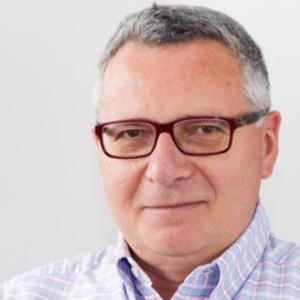Franc Solina
Franc Solina | |
|---|---|
 | |
| Born | July 31, 1955 Celje, Slovenia |
| Nationality | Slovenian |
| Citizenship | Slovenia |
| Education | M.S. degree in electrical engineering Ph.D. degree in computer science |
| Alma mater | University of Ljubljana University of Pennsylvania |
| Known for | computer vision superquadrics |
| Children | Nataša Remic (Daughter) |
| Awards | IAPR Fellow Award (2002) |
| Scientific career | |
| Fields | Computer science |
| Institutions | University of Ljubljana |
| Doctoral advisor | Ruzena Bajcsy |
| Website | fri |
Franc Solina, Slovenian computer scientist and university professor, (31.07.1955, Celje, Slovenia)
Education
After finishing the Bežigrad Grammar School in 1974 Solina enrolled at the Faculty of Electrical Engineering, University of Ljubljana where he graduated in 1979 and received in 1982 also his M.S. degree in electrical engineering. In 1987 Solina received his Ph.D. degree in computer science from the University of Pennsylvania.[1] His doctoral advisor was Ruzena Bajcsy, director of the GRASP Laboratory at the University of Pennsylvania School of Engineering and Applied Science.[2]
Research
In 1988 Solina started to teach computer science at the University of Ljubljana where he became a full professor at the Faculty of Computer and Information Science in 1998. In 1991 Solina founded the Computer vision laboratory [3] where research in computer vision, multimedia and human–computer interaction is taking place. Since 1999 he is also the head of the nationally funded research programe Computer Vision.[4] Solina published more than 200 peer reviewed research articles.[5]
Solina pioneered the interpretation of range images using superquadrics as part-level volumetric models.[6] He also integrated the recovery of individual superquadric models with segmentation of range images into several individual parts.[7] Solina's superquadrics recovery method is used in many different disciplines, ranging from grasp and path planning in robotics to modelling the shape of body parts and organs in medicine. Solina himself is using superquadric modeling in digital heritage to model archeological artefacts.[8] According to Google Scholar, citations of Solina's publications related to modelling with supequadrics exceeded in March 2020 the number 1700.
For contributions to interpretation of range images and for service to IAPR Solina became an IAPR Fellow in 2002.[9]
Franc Solina became engaged also in new media art where he uses his knowledge of computer technology for production of interactive and installation art,[10] but also for his own art projects.[11][12] Due to his artistic involvement Solina became a member of the Slovenian Association of Fine Artists. Since 2012 he teaches also in the Video and New Media study program at the Academy of Fine Arts and Design in Ljubljana.
Commissions of trust
Between 2006 and 2010 Solina served as the Dean of the Faculty of Computer and Information Science.[13] For the period of 2010-2014 he was nominated by the Government of Slovenia to the Board of Governors of Jožef Stefan Institute in Ljubljana.[14] Franc Solina frequently comments on technology issues in Slovenian press[15] and on television.[16]
Franc Solina became in 2018 a regular member of the European Academy of Science and Arts (Academia Scientiarum et Artium Europaea) in Salzburg.[17]
External Links
See also
References
- ↑ Shape recovery and segmentation with deformable part models Doctoral dissertation in Computer and Information Science, University of Pennsylvania, 1987.
- ↑ Franc Solina at Mathematics Genealogy Project
- ↑ Computer Vision Laboratory
- ↑ Research programe Computer Vision
- ↑ Franc Solina in the Slovenian national bibliographic system COBISS
- ↑ Franc Solina, Ruzena Bajcsy. Recovery of parametric models from range images: The case for superquadrics with global deformations, IEEE Transactions on Pattern Analysis and Machine Intelligence PAMI-12 (2):131–147, 1990.
- ↑ Aleš Jaklič, Aleš Leonardis, Franc Solina. "Segmentation and Recovery of Superquadrics". Computational imaging and vision 20, Kluwer, Dordrecht, 2000.
- ↑ Aleš Jaklič, Miran Erič, Igor Mihajlović, Žiga Stopinšek, Franc Solina. "Volumetric models from 3D point clouds: The case study of sarcophagi cargo from a 2nd/3rd century AD Roman shipwreck near Sutivan on island Brač, Croatia". Journal of Archaeological Science 62 (October):143–152, 2015.
- ↑ "Recipients of the IAPR Fellow Award". IAPR.org. IAPR. Retrieved 1 March 2020.
- ↑ Exhibition | Srečo Dragan: Space is out of joint, MG+MSUM, Museum of contemporary art, Ljubljana 22 December 2016 — 05 March 2017
- ↑ Franc Solina. 15 seconds of fame, Leonardo 37(2):105–110, 2004.
- ↑ Franc Solina, Blaž Meden.Light fountain - a virtually enhanced stone sculpture, Digital Creativity 28(2):89–102, 2017.
- ↑ FRI 20 : 1996-2016 : 20 let Fakultete za računalništvo in informatiko Univerze v Ljubljani, 2016
- ↑ Annual Report 2010, Jožef Stefan Institute, Ljubljana, Slovenia, page 10.
- ↑ Ivan Bratko, Franc Solina. Zlorabe na spletu so večja grožnja človeku kot robotika. Delo, ISSN 0350-7521, 7 February 2015.
- ↑ Aleš Ude, Marko Munih, Franc Solina, Andrej Žužek, Sebastjan Šlajpah. Prihodnost tu in zdaj - robotika : oddaja Polnočni klub. Ljubljana: TV Slovenija 2, 20 November 2015.
- ↑ Membership directory of the European Academy of Science and Arts
This article "Franc Solina" is from Wikipedia. The list of its authors can be seen in its historical. Articles taken from Draft Namespace on Wikipedia could be accessed on Wikipedia's Draft Namespace.
- 1955 births
- Living people
- Computer vision researchers
- Fellows of the International Association for Pattern Recognition
- Slovenian computer scientists
- University of Ljubljana alumni
- University of Pennsylvania School of Engineering and Applied Science alumni
- University of Ljubljana faculty
- People from Ljubljana
- Members of the European Academy of Sciences and Arts